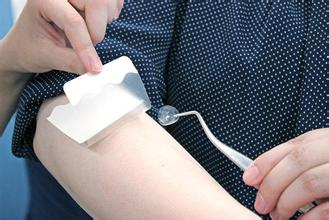A paper published this month shows that researchers in Japan have successfully grown fully-functioning mouse skin in a laboratory, from a set of reprogrammed cells.
本月刊登的一篇文章指出,在實驗室狀態下,日本的研究人員從一組基因重組的細胞中,成功地制成了能夠模仿正常組織功能的老鼠皮膚。
Researchers were able to grow the independent sections of mouse skin tissue thanks to an advance from nearly a decade ago, when the scientific community learned how to take young cells and reprogram them to grow into a different kind of cell. In this case, cells from the gums of mice were redirected to become skin cells.
研究人員能夠制成獨立的老鼠皮膚組織,多虧了近十年前科學界成功提取幼細胞并將其重組成其他種類的細胞。在這種情況下,研究人員通過提取老鼠牙齦細胞,然后把它們轉換皮膚細胞。
Skin grafts are a big deal in the world of life-saving technology, as functioning skin is slow to create from grafts, leaving the body vulnerable. Healthy skin produces vitamins, protects the body from infection, and regulates body temperatures. But current graft techniques don't create a solution that can do that immediately.
皮膚移植技術對于挽救生命意義重大,因為移植后,正常的皮膚生長很慢,使身體容易受感染。健康的皮膚能產生維生素,保護身體免受感染,并調節體溫。但是,目前的移植技術還不能提供解決方案,立刻做到這一點。

In fact, the "skin" grown in labs for grafting isn't nearly as complex or functional as what you've already got on your body. In many cases it's less like a full organ and more like a top layer, able to literally cover an exposed area, and not much else until the rest of the body regenerates underneath.
其實,以往實驗室制成的用作移植的"皮膚",并不像人體身上的皮膚有那么多復雜的功能。在許多情況下,它并不像一個完整器官,而更像一個表層,能夠覆蓋住暴露區域,直到身體皮膚下面的其余部分再生。
But this new process is different: The skin is already fully functional on its own, producing everything from hair and oil to sweat, just like normal skin does. That means it's ready to go much faster than the skin that would essentially have to do that growing after grafting—rapidly speeding up the healing process.
但這個新過程是不同的:這種皮膚功能齊全,可生長毛發,分泌油脂和汗液,就像人的正常皮膚一樣。這意味著,相比之前的移植后皮膚的生長,這種皮膚能夠大大加速愈合過程。
But lab-grown skin doesn't just pose major breakthroughs for burn treatments. Lab-grown, fully functional skin could have another value to the world, as a contributor at Allure pointed out: getting rid of animal testing. That's right—all those animals used for topical testing of medications and cosmetics stand to escape the cages, because fully functioning samples of human cells would be astronomically more effective for testing of those products than furrier animal friends.
實驗室培育的皮膚不僅僅對于燒傷治療是重大突破。這種實驗室制成的,功能齊全的皮膚在其他領域也有其價值。美國《魅力》(Allure)雜志指出:不要再局限于動物測試。是的,是這樣的——所有用于藥物或化妝品測試的動物們都想要逃出牢籠,而相對于有毛的動物朋友來說,用功能齊全的人體細胞樣品來測試這些產品,效果要大得多。
Of course both grafting and testing advances are still a few steps down the road. While mice responded well to these skin samples, the technology needs to be adapted for human use. The Washington Post reported that scientists estimate they're 5 to 10 years from actually being able to successfully replicate the process with human skin.
當然,無論是移植還是測試的進展仍還要繼續。雖然老鼠們對于這些皮膚的反應令人可喜,但該技術還需適于人類使用。華盛頓郵報報道,科學家估計在5到10年之間能成功將這一技術用于人類皮膚。
For the moment they still have many questions to answer about the mouse-based results, and the process needs to be replicated successfully by other researchers before anyone can start asking how to replicate it with human cells.
就目前而言,基于老鼠試驗下的皮膚成果,科學家們還有很多問題需要回答。在開始將其復制到人體細胞上之前,這一過程也需要其他研究者的成功復制,來證明其有效性。
But once it happens, the applications are endless, from better cosmetic surgery results from healthy new tissues, to lifesaving and immediate procedures aiding burn victims that today would likely not stand a chance of survival.
但是,一旦成功,應用是無止境的,不管是更好的美容手術效果和健康的新組織,還是拯救生命,即時幫助燒傷患者(如今的他們可能沒有一線生機)。
Suddenly a bodiless, pulsating patch of hairy, oily, sweaty mouse skin in a petri dish doesn't seem so gross.
突然間,培養器皿中那塊毛茸茸的、油膩膩,汗濕濕的老鼠皮似乎不那么惡心了。












